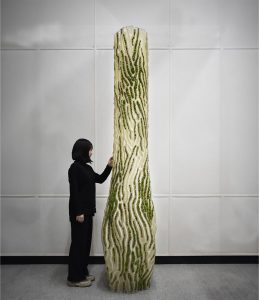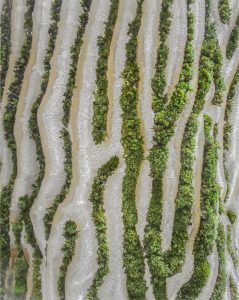
Designed by Yong Ju Lee Architecture, Moss Column prototype aims to explore the fusion of living organisms and architecture. Following the COVID-19 pandemic, there has been a renewed interest in sustainable design and a need to re-evaluate the built environment. However, the construction materials used in contemporary architecture have remained largely unchanged despite the various methods employed for sustainable design.
In this experiment, plants are directly embedded into artificial materials using a novel approach. Mosses have been chosen as the primary plant for this experiment due to their non-vascular nature, which means they do not grow tall and use roots only for anchoring. To achieve complex and high-resolution patterns for embedding, geometry is manipulated and generated through computational design tools.


Advanced construction technologies such as a large-scale 3D printer with an industrial robotic arm are used to realize the complex forms. The experiment, named Moss Column, represents an updated approach to seamlessly merge natural life with man-made structures, capturing the visual representation of artificial structures blending harmoniously with natural elements and mimicking the organic dissolution process.
Unlike the previous project that used Boolean operations to attach mosses, a more subtle and sophisticated pattern is employed to inherently blend the natural and artificial elements. A mathematical model known as a reaction-diffusion system is used to describe the spatial and temporal changes in the concentration of one or more chemical substances. An overall vertical form is generated through the design algorithm derived from this model, with the foreground (moss) merging into its background (3D printed structure) over a height of 2,400 mm.

To achieve effective large-scale 3D printing, Fused Granulate Fabrication (FGF) is utilized, with an extruder operated at the end of a 6-axis robotic arm (ABB IRB-4600) and a nozzle size of 2mm for PLA pellets. The vertically stacking fabrication process becomes a design constraint, influencing the establishment of a custom workflow. This attempt provides an active and radical solution for integrating organic and inorganic matter through a single-body geometric system. It highlights the interaction and exchange of respiratory and photosynthetic byproducts between people and nature.
The use of eco-friendly architectural techniques in conjunction with moss is expected to bring significant transformations to the future construction industry. This presents the potential for sustainable implementation in the digital era by establishing new relationships among digital, physical, and natural elements, paving the way for a harmonious coexistence between urban environments and the natural world.


Project Info
Architect: Yong Ju Lee Architecture
Fabrication: Robotic Fabrication Studio from Seoul National University of Science and Technology
Design Team: Jisu Noh and Hyun Kyung Yoo


















































